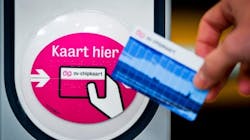Best practices in national transportation ticketing schemes in Europe
The past three months have created a series of public health, economic, social and business crises throughout much of the world. The impact has been severe on the previously assumed essential need for universal mobility and the need to deliver mobility in an economic, comprehensive and integrated manner that offers ongoing improvements in environmental sustainability. While there will be changes in mobility in cities around the world, several of the basics for a robust transport system will remain: One of these is efficient and effective ticketing.
While Mobility as a Service (MaaS) has been pursuing a universal smart phone app that will link all of one’s daily travel needs into a single online portal, a more basic need is single, or at least reduced, ticketing products that enable seamless movement between the range of transport services that a user may need.
Over the past few years, significant progress made has been made on this agenda in a range of global and European cities and countries. From the Oyster card and then contactless bank cards in London, to the Navigo card in Paris, several European cities are deploying city-based smartcards or smart platforms for users of their public transport services. However, few cities have been able to extend these public transport focused smartcards to coverall mobility options such as micro-mobility and car or ridesharing. Some of the independent MaaS businesses have entered the market with more comprehensive city-based mobility offers that include public transport, as well as other privately operated local mobility options. This includes services developed by for example Masabi, Trafi or Skedgo.
The Netherlands will transform its card-based scheme to have a ‘more flexible back office’ system
The Netherlands has a history of operating a national public transportation ticketing system. The country is densely populated, particularly in the western area known as The Randstad. Public transit use is also very popular and used within and between the closely located cities. This urban structure also has encouraged the development of numerous local transportation operators, as well as the national train operator – Nederlandse Spoorwegen (NS).
Thus, the “strippenkaart” was created in 1980s as an integrated means of ticketing across The Netherlands. The paper-based tickets enabled users to validate a certain number of “strips” for each type of public transit journey. The practical and transferrable system was operated through 2011. Without contemporary capabilities in personalization, revenue apportionment or system data use, the strippenkaart became outdated. However, its national basis was the forerunner for the development of the “Openbaar Vervoer chipkaart” (OV chipkaart) ticket.
The OV chipkaart covers all public transport in the country and is managed by NS, the local public transit operators in the largest three cities, as well as the largest bus operator. The scheme’s deployment started in 2005 and continued to 2011 – the eventual end date of the strippenkaaart. By 2010, the OV chipkaart was the only system available for public transit users in the largest cities, Amsterdam and Rotterdam. By 2014, NS rolled its single ticket products onto the OV card.
The system is based on a reusable chip-based card that can be personalized or remain anonymous. Single products are placed on low cost, disposable media, while longer term personalized cards are placed on higher quality smartcards. Users must touch in and out of the public transit modes. This has led to an increase in gating of key rail stations across the country and in some cases, such as Amsterdam Centraal, some complicated gating arrangement in an historic and highly-used station. An app has been developed to support the product, but the card remains the core element of the service. Half of the cards in circulation are anonymous and 14 million cards were in use in 2018.
A number of operational and practical issues have arisen. Public transit is at the core of life in The Netherlands, alongside cycling and multi-directional, multi-centred mobility is a fundamental need that both the strippenkaart and OV-chipkaart are well suited to serve. Thus, use of these products is widespread.
However, developing, testing and running such a complex system across all public transit modes in the country has been expensive and time consuming to implement. The universality of the OV card has in some ways restricted flexibility and innovation in Dutch ticketing systems as any innovation must fit within a single national framework.
The continued need for low cost, disposable tickets, particularly for the large numbers of tourists and business visitors in the country, has created extra costs and product oddities – local disposable use tickets cannot be re-used in other parts of the country although they otherwise seem to be smartcards.
As the OV-card remains a card-based scheme, customer service in the contemporary world including value tops ups, product visibility, loss of product, transferability, refunds, etc., remain complex and expensive, which leads to ongoing customer service complaints.
The Dutch government has thus announced that by 2023 they hope to take the essence of the benefits of the OV-card into a more flexible “back office” account based system. This is a rapid and ambitious transformation but should provide the country with enhanced benefits within a national public transit ticketing system. It should also be expected that attempts will be made to expand the ticketing products to include other forms of new mobility. This will also support the development of MaaS systems.
Denmark’s smartcard scheme faces issues when compared to online account-based services and apps
Denmark has also progressed the development of a national public transit ticketing strategy. The country of approximately six million is dominated by Copenhagen with two million residents. However, spread across a number of islands and a mainland peninsula are a number smaller cities and rural hinterlands. The country is also a busy corridor between the rest of Scandinavia and the rest of Europe via Germany. Like The Netherlands, public transport is well developed via the national rail operator Danske Statsbaner (DSB), city-based metros, as well as urban and interurban bus services. Cycling is also a dominate form of transport, particularly in Copenhagen.
A national zonal-based transport scheme had already been in place for a number of years when the national “Rejsekort” ticketing system began to be rolled out in stages between 2008 and 2011. National rail paper tickets were withdrawn in 2019.
The overall system is managed by a consortium of DSB, Copenhagen’s regional transport agency, a major development authority for southern Copenhagen as well as a major national bus operator. All public transport modes in the country are included. Personal, as well as anonymous tickets are available. Travel is priced on a point-to-point distance-based measure. Again, users must tap in and out of each mode. Of note is the lack of station gating on the national rail network, which is common in many European countries such as Germany and Switzerland and unlike the smartcard deployment in The Netherlands. Local operator and city-based ticketing is also still available in some areas.
While the idea of a national ticketing strategy seems attractive and a natural evolution of the national zonal-based pricing, the Danish experience has been problematic. This is in a country with a strong culture and interest in public and sustainable transportation. The actual user experience of the smartcard is continually criticized as counter intuitive, complex and slow to respond to customer needs. The project was late in delivery and significantly over the original budget. Rolling out such initiatives is expected to be complex, but the resulting smartcard-based scheme also faces the issues of comparison with online account based services and apps.
The scheme also has not been implemented on the busy Oresund rail crossing which has integrated the Copenhagen labour and business market with Malmo in Sweden.
In both the Dutch and Danish examples smartphone apps are being used for customer support, but the product value remains on the smartcards.
Of further note is the “Mobib” smartcard in Belgium which has integrated ticketing across the three large regional public transport operators as well as the national rail operator SNCB since 2008. Again, the scheme is smartcard based.
The Mobib scheme has also integrated with various new mobility partners such as bike sharing, bike parking and shared cars.
Hungary has also advanced national rail ticketing thinking with the new national identity card – four million are in circulation. This smartcard, which was introduced in 2016, is used for identification, for some international travel, voting ID, social benefits, etc. It has also included in the specification the ability to hold transport products although this ability is only slowly being deployed in new transport products.
Despite national rollouts, countries still face setbacks of project delays and running over budget
National public transit ticketing schemes are being deployed in a range of European countries. These products are fully deployed and operational in many cases, while other countries continue to consider their feasibility, benefits and applicability. A common issue remains delivery of the scheme on time and in budget in complex multi-stakeholder environments and with existing client and user expectations.
The nature of smartcard tickets and their operational, as well as customer service via a card-based system remains challenging in many cases. While, for example, London has successfully over a numer of years deployed its Oyster card system and developed high customer satisfaction and usability, this city has already moved to account based ticketing via contactless products and several of the European national tickets are also moving in this direction.
The case for account-based ticketing is strong, and clearly MasterCard, Visa, American Express and others are encouraging this thinking. It raises the prospect that a true national transit ticket – and in fact, international ticket, could be an account-based product delivered via these card providers. This is a simplified prospect, but without the complete local transit operator(s) control of their own smartcard products.
Similarly, app-based ticketing via global technology products such as Google Pay, Apple Pay and Samsung Pay offer a flexible means of delivering the outcomes of a national ticketing strategy.
All of these products are also useful for the eventual development and deployment of MaaS solutions – either public sector delivered or via private sector intermediaries that depend ultimately on a rich and flexible set of transport data.
----------------------------------------
Giles K Bailey is a director at Stratageeb Limited, a London based consultancy assisting businesses think about their strategic vision and innovation. Previously, he had spent nine years as head of Strategy at Transport for London. He has worked in the UK and Canada over the last 25 years in mobility, innovation, marketing, digital, transport planning and consulting.About the Author

Giles Bailey
Director, Stratageeb Limited
Giles Bailey is a director at Stratageeb Limited, a London-based consultancy assisting businesses in how they think about their strategic vision and innovation. Previously, he had spent nine years as head of strategy at Transport for London. He has worked in the UK and Canada over the last 25 years in mobility, innovation, marketing, digital, transport planning and consulting.
